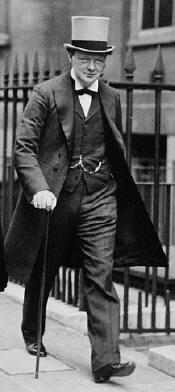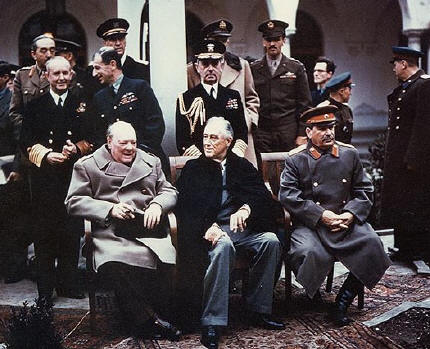The Cold War - A History
1917-1945
The Cold War began at the conclusion of World War II in 1945. To put into perspective the uneasy and often hostile relationship between the United States and the Soviet Union, it is important to touch briefly on the origins of the Cold War which date back to the latter part of World War I. The real or perceived threat to the Western way of life generated by Communism, and the resulting apprehension on the part of Americans and Western Europeans is easy to understand. Yet, the anxieties and often near paranoia expressed by people in the East, particularly the Russians, about the fear of being attacked by the West has often mystified westerners. Some causes for Russian suspicion and fear can be found rooted in events that took place during and after the Russian Revolution.
In 1917 the Czar’s army, badly bruised and demoralized, was on the brink of collapse. Vladmir Lenin, with German support, had come out of exile and returned to Russia. During the revolutions of 1917 and the subsequent Civil War in Russia, Lenin and other Bolsheviks assumed power and established a communist state.
The events alarmed the West for a number of reasons. One, the collapse of Russia in the east released German soldiers for combat on the western front. Great stores of supplies were stockpiled in Russian ports which the allies feared would fall into German hands. Some 40,000 Czechoslovakian soldiers had been fighting alongside the Russians against Germany and were essentially stranded in Russia. The British were alarmed at the Communist takeover in Russia and viewed Lenin and his followers as a threat to western ways and ideology. Americans, having supported the war to protect free peoples also felt threatened by the situation in Russia.

Prime Minister Winston Churchill
President Woodrow Wilson was reluctant to respond directly to events in Russia at first, but gave in to pressure from Winston Churchill and others in Great Britain. He was also influenced by events, particularly the armistice between Russia and Germany in December 1917, and later, the Brest-Litovsk Treaty of March 3, 1918.
Allied troops under British command were dispatched to Russia in August 1918 and took the city of Archangel. Some 9,000 American troops soon joined the force and were engaged militarily against the Bolsheviks. In addition to the reasons earlier stated for being in Russia, the Americans also fit into a British plan to overthrow the Bolsheviks. Moreover, since the Japanese also sent a large contingency of troops to Russia, there was a concern on the part of the American government about Japanese designs.
The Americans did not withdraw from Russia until 1919, long after hostilities had ended. Whatever the motives, right or wrong, Russians from that point on retained a vivid recollection of an ‘invasion’ of their homeland by an Anglo-American army. The collective memory played a large role in creating a perception in the minds of future Russians that we were quite capable of repeating the act.
That Woodrow Wilson and his three successors refused to recognize the Soviet government played a role as well in fomenting hostilities. When Germany was invited to join the League of Nations in 1925 but Russia was not, resentment simply deepened along with Russian suspicion that Germany would be re-armed and again be a threat to Russia.
The United States formally recognized the Soviet Union during the Roosevelt administration in 1933. Prior to the beginning of WWII, tensions between Russia and the West again escalated when the Soviet Union and Germany signed a non-aggression pact in August 1939. The pact essentially gave Hitler a free hand to invade Poland a few short weeks later, and to unleash his military in Europe without concerns about an ‘eastern front’. For Stalin’s part, he was able to acquire the Baltic states and share in the division of Poland. In effect, the Soviet Union began building a buffer zone along its western frontier. At the same time, its actions aroused suspicions in Britain and the U.S. regarding its long range intentions.
Aggravating the situation more was the fact that Britain had been passing intelligence on to Stalin concerning Hitler’s intentions which Stalin chose to ignore. After the German invasion of the Soviet Union, Stalin of course allied himself with the U.S. and Great Britain and the war effort hinged on the ability of the ‘Big Three’ to plan and work together to defeat Nazi Germany.
In the course of events including Big Three conferences, Roosevelt was focused on defeating Germany and was somewhat taken in by Stalin’s personality whereas Churchill looked beyond the defeat of Germany and to the containment of Communism.
Stalin and the Soviets for their part had no plans of giving up territory acquired as a result of the earlier Soviet-German pact, or during the ensuing conflict. The fact that Russia had been invaded twice in a short span of time by Germany and by allied nations as well influenced Soviet thinking. While Churchill pressed for a resolution of territorial issues during the war, Roosevelt felt that the issues could be resolved after Germany and Japan were defeated.

Churchill-Roosevelt-Stalin at the Yalta conference.
The Cold War-Significant Events
1945 – 1955
The Intelligence Void
With the end of WWII, the United States emerged as a super power. No longer in isolation, the U.S. recognized the need to play a part in global affairs and protect its interests and security through a projection of power and influence. President Roosevelt had died and was succeeded by Harry S. Truman.
As for the Soviet Union, the U.S. found that an intelligence gap existed and very little was known about the internal workings of Stalin’s regime. Truman and Churchill agreed early on that containment of the Soviet Union and its influence in Europe were a first order of priority. However, there existed a need to establish a reliable intelligence network within the Soviet Union and at the time only one group was in place to meet the needs of the U.S. The remnant of the Abwehr, German intelligence, under the command of General Reinhard Gehlen made itself available to the OSS (Office of Strategic Services), the latter becoming the CIA in 1947. With over 2,000 former Nazi agents on the scene within the Soviet Union, the ‘Gehlen Organization’ solidified its relationship with the CIA and was a primary source of intelligence on the Soviet Union for years to come. In 1956, Gehlen founded the BND or German Intelligence Service which continues to this day.
While the partnership between Gehlen and the U.S. is a story in and of itself, the reader can safely surmise that a good deal of information transmitted to the U.S. from Gehlen about the Soviet Union was intended to help heighten our suspicions and fears about Soviet planning and intentions.
George F. Kennan, charge d’affaires for the U.S. in Moscow responded to an urgent request from the State Department for information on the Soviets with his ‘long telegram’ of February 1946. In it, he made an assessment that essentially indicated that Russia was not so much a military threat to the West as long as the latter maintained a strong force, rather, the Soviets presented a real political threat to western countries.
Kennan, and later Dwight D. Eisenhower as President, did not think, as long as mistakes were not made, that there would be a military confrontation between the Soviets and the West in Europe.
The Truman Doctrine
Détente having been the basis for American-Soviet relations immediately after WWII, the Truman Doctrine of 1947 launched a policy of containment. Basically stating our support for Greece and Turkey not falling within the Soviet sphere, the doctrine clearly stated our intent to contain Soviet influence outside of its boundaries. Truman’s policies agreed with Kennan’s assessment that firmness and force could contain Soviet political ambitions and prevent military action.
The Berlin Airlift served to attest to that assessment as a potential major confrontation with the Soviets was neutralized with force and determination.
NATO – Germany Partitioned – Korean War
NATO was established in 1949 and in that year, the Federal Republic of Germany was formed. In response, Stalin created the East German state. Berlin was and remained a bone of contention for West and East. In the not too distant future, it would be a catalyst for either a major war, or a move towards ‘softer relations’ between the Americans and Soviets.
While Korea was geographically removed from Europe, it was in fact a place where free peoples were tested mightily by the communist regimes in China and the USSR. During the years 1950 to 1953, the East and West contested each other militarily. When Stalin died, a senior member of the Soviet government, Malenkov, pushed the Communist side for a cease fire and armistice talks and the fighting finally ceased.
West Germany enters Nato – Warsaw Pact Is Formed
Another factor that raised concern in the USSR about western intentions was the re-arming of West Germany. When in fact West Germany joined NATO on May 9, 1955, the Soviets responded immediately with the establishment of the Warsaw Pact, May 14, 1955. West Germany had some conditions for joining given its own fear of Soviet reprisal. Our German allies did not want their country to be a battleground, at least, not without substantial defense. In a form of quid pro quo, NATO agreed to a ‘forward defense’ strategy which called for forward deployment of NATO forces, up against the Soviet-East bloc boundaries. From that point on, we were nose to nose.
It was soon after that the 3rd Armored Division took up position, nose to nose with Soviet forces, and participated in the defense of American security and Europe. The Cold War Time Line with a substantial number of major events continued on until in 1989, the Soviet empire ceased to exist. That time line and its events will be covered in a separate page. It is hoped that the Cold War History, to this point, will help the reader understand the basis for some of the tensions that developed between West and East.
